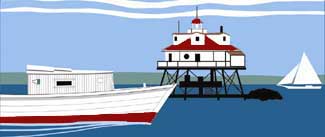
Interpretation Plan Sets the Course for Future Exhibits
After a lengthy competitive bidding process, the Annapolis Maritime Museum has contracted with C&G Partners, a prestigious exhibit design firm from New York, to create a master exhibit plan based on the Museum’s interpretive plan.
Dr. Bill Dudley headed the Interpretive Committee that forged the plan. Dr. Dudley recently retired from a career as Director of the Naval Historical Center and Director of Naval History for the Chief of Naval Operations. In this capacity he also served as Curator for the Navy and Coordinator of Navy Museums. The committee included Buck Buchanan, Jane Cox, Jeff Holland, Mechelle Kerns-Nocerito, Elizabeth Stewart, Peter Tasi, Elvia Thompson-Staller, Peg Wallace, and John Wing.
Right: Native Americans were the first watermen
The five primary themes selected for interpretation by the Museum were mined from extensive discussions with various board members and interested parties over a multi-year process. The historic context of Annapolis and Anne Arundel County will provide residents and visitors alike a basis for exploring the diverse maritime culture that has flourished here for the past 400 years.
The Colonial Era – The shores of the area were settled by Native Americans prior to the settling of Providence in 1649. The first European settlement in Anne Arundel County was a result of the Annapolis area’s unique and favorable geographic situation and of political and cultural pressures that the colonists encountered in the early settlement of the Maryland. Soon, the population center exploded and it became clear that the settlers on the banks of the Severn River were a force to be reckoned with. The State capital moved north from St Mary’s City in 1694 and Annapolis soon rose to prominence as a political, cultural, and maritime center in the Colonies. This background, with a notable maritime bent, provides the background story for the maritime heritage the Museum strives to share.
The Maritime Trades – This colonial account will enable the AMM to explore the marine trades industry that has flourished since the earliest settlement. With such a vibrant modern maritime industry in Annapolis, the historical antecedents and their modern equivalents become a compelling story that will inform today’s society, not just tell a story of the past. Boat building is a specific endeavor within the Marine Trades that has a rich past in Annapolis and has provided the groundwork for today’s industry. The stories of historic boat building and the tradesmen who worked in the industry will be a main stay of the AMM experience.
Navigation – With boat building comes the need for navigation and the partnership with the United States Lighthouse Society, Anne Arundel County and the City of Annapolis to manage the Thomas Point Shoal Lighthouse offers a truly unique opportunity to tell the story of coastal navigation and its significance. The topic is an obvious primary theme that the AMM has embraced. Not only is there a unique historic preservation story to be told with the National Historic Landmark Lighthouse, but the lighthouse serves also as a symbol of the navigational aids that have enabled commerce and travel on the Chesapeake throughout the 400 years on which the AMM will focus. The Lighthouse also offers an opportunity to relate this region’s maritime past to the larger topic of the Chesapeake Bay’s maritime heritage.
Seafood Industry & Oysters – The McNasby Oyster Company building, located in the heart of Eastport—an historically integrated waterman’s community—has the obvious potential to tell the compelling story of the waterman working on the Bay, and in particular the history of oystering on the Chesapeake. This focuses upon the power of an authentic place, one that uses the remnant of an oyster packing house to bring to life the extraordinary stories of everyday people involved in the seafood industry of the Bay.
Recreational Boating – The final element of the AMM story is the rise of recreational boating on the Chesapeake Bay. Recreational boating is what Annapolis is well-known for today and its moniker as “America’s Sailing Capital” is one that, though contested, has many supporters. It is the essence of this title on which the AMM will focus its efforts, from the historic development of recreational boating in the late 19th and early 20th century to its impact on the economy and cultural identity of Annapolitans today.
| Contact Us | Join | Community Links | Press Room |
| Exhibits | Films & Concerts | Special Events | Home |
| Sitemap | Board Members Only |
Annapolis Maritime Museum
PO Box 3088
Annapolis, MD 21403
410 295-0104
office@amaritime.org
